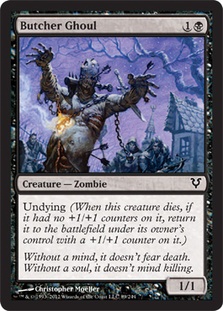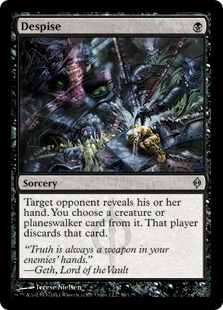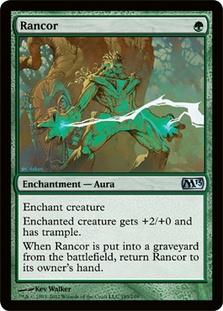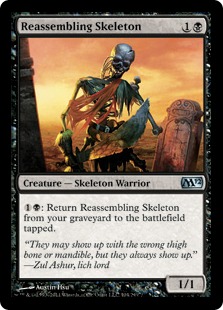A commenter on my previous article pointed out that none of four represented decks had any touch of black. It’s a very fair point that perfectly describes a problem in current Standard. All possible black decks are black-heavy, and only one of them is popular. Zombies’ bad luck is having a relatively good matchup against Delver, and, due to it, dedicated hate directed at it from the best deck in the format.
Simultaneously, control is weak, no matter what color, so black has one less general representation. Even the very promising Mono-Black Control, recently granted cards like Mutilate and Trading Post, is not very popular. Is this bad luck, too? Yes. Are there any ways to improve the situation? Of course! There is always room to improve, at least if you haven’t just discovered that you’re on rover on Mars, it’s -153 degrees Celsius, and nobody bothered to pack you a sweater.
I’m going to start with the universally adopted avatar of bad luck: Black Cat. The little kitty was never good enough for aggressive Zombies lists, but it is far more potent than its white counterpart. I saw Black Cat recently in a Smallpox deck (in both a Magic Online Daily Event and a SCG Premium Newsletter), so I’ll start from that point. Smallpox is an interesting card which has seen play in different formats (for example, a Legacy deck played by Reid Duke), but its latest visit to Standard was unsuccessful.
The problem is that slow grinding aimed at overpowering opponents due to their lack of resources is a bad idea in the world of Snapcaster Mage, Timely Reinforcements, and Thragtusk. Moreover, there is no Cursed Scroll or The Rack in Standard, so finishing opponents from the point of mutual resource shortness is problematic. Nevertheless, there is still a way to use Smallpox —not to limit opponents’ resources but to completely devastate their game and then recover much faster.
Luckily, current Standard has many tools: undying, flashback, and Liliana of the Veil, not even mentioning the good removal spells to keep opposing threats in check. The most obvious starting point is a kind of Zombies deck. Gravecrawler is a reasonable beater and a perfect card to discard for Smallpox, and Geralf’s Messenger is unquestionably one of the best creatures in Standard. I reworked the deck I saw in a Daily Event (credit goes to Calligard) and came to the following.
Creatures (16)
Planeswalkers (4)
Lands (23)
Spells (17)

The concept is very simple. We have a large amount of ways to beat both a Delver of Secrets and Birds of Paradise start from the opponent, and then we can put them out of the game with Smallpox (which is great against, say, Geist of Saint Traft). If we’re going first, turn 2 Smallpox will probably be enough, especially if we’re discarding Lingering Souls and then play Liliana of the Veil. Eight cards to discard improves Smallpox from a three-for-three (assuming we didn’t have a creature) to a two-for-three. Black Cat allows a three-for-four if sacrificed (and random discard among the opponent’s best cards is a huge deal) or threatens the opponent with additional discard until Liliana of the Veil can finish the work.
I wanted to include more Zombies to support Gravecrawler, so a pair of Butcher Ghouls came in the deck instead of Ravenous Rats. Butcher Ghoul looks very unattractive, but it was actually good during our Block Constructed tests for PT Avacyn Restored and was bearable in this deck too. Maybe cutting Rats is a mistake (as we want opponents to discard all their cards), but the deck is so light on threats that a 2/2 body is very relevant. Threats are the weakest part of the deck (none of them is anywhere near Geralf’s Messenger), so I considered Moriok Replica instead of Sign in Blood and Reassembling Skeleton as Lingering Souls number five. This is also the reason for Vampire Nighthawk in the sideboard.
The sideboard contains additional discard: Despise for Wolf Run Ramp and Thragtusk and Duress for Birthing Pod. Unfortunately, we can’t reasonably play white cards like Divine Offering due only six white mana sources; it’s too late to deal with turn 2 Birthing Pod, so this troublesome matchup must be dealt with through discard. Just ensure that the Pod player doesn’t have enough mana to cast Thragtusk. Surgical Extraction is our weapon against another troublesome advantage generator: Snapcaster Mage. I generally dislike this card, but it’s near perfect in response to Mage’s trigger targeting Ponder or Vapor Snag (though Snag is not really good against any of our creatures).
This deck is not the best; it has some disadvantages which will keep it from being tier 1, but it’s interesting to play and has a relatively good matchup against Delver decks, so it may be worth trying if you’re ready to spend some time on fine-tuning and playtesting.
The main problem with this deck is its threat quality, and the best possible way to make tiny creatures reasonable threats is Rancor, so the decision to try another color is almost natural. Cutting white, we lose some sweet sideboard options and Lingering Souls… Wait, I assume that I don’t normally cast Lingering Souls early, discarding it to Smallpox or Liliana of the Veil instead. So cutting white doesn’t inevitably mean cutting Lingering Souls (but the card does become worse). Reassembling Skeleton is a possible substitute, which becomes better with infinite recursion and Rancor. Let’s look at my new attempt:
Creatures (19)
Planeswalkers (4)
Lands (23)
Spells (14)
Sideboard

I tried different mixes of Lingering Souls / Reassembling Skeleton / Butcher Ghoul and finally came to be all-in on Skeleton—an endless stream of Rancored attackers is exactly where I want to be. The last changes are Brindle Boar in the sideboard (I’d like to see Tree of Redemption, but four mana is too much) and an additional Forest maindeck due to the necessity of Rancor. Ultimately, the B/G version wasn’t really superior to B/W (mostly due to issues with casting Rancor and Geralf’s Messenger), but it was better when everything went good. I know that’s not a very good recommendation, but both decks require a bit of luck for success, so it’s a fair point.
I also examined heavier versions of Smallpox decks (one from a Daily Event and another by a reader), exchanging the Zombies package for some serious beats through Unburial Rites or some artifact mana acceleration. Honestly, you need some reasonable density of threats to fight through topdecked removal spells and to have an early clock. I have a superstitious fear of decks trying to draw Unburial Rites for five or six turns and simultaneously praying for the opponent to not have one more creature. I just prefer W/B/R Reanimator, as it’s well suited to sweep the board and finds its tools fast enough for actual win.
That’s all about Standard strategy for today. Next weekend will feature the inaugural Magic World Cup, and I’m super excited to see how the biggest change to Magic Premier Play will work out. Though the United States, Belgium, and Slovakia are the generally adopted favorites, I expect to see some unpredictable things this weekend due to the team nature of the competition.
Despite Russia, Ukraine, and Belarus definitely not being favorites, they all are strong and promising, so I recommend taking a look at all three.
The Belarus team features LSV’s bane, Nicolay Potovin, who has returned to Magic after a long break to represent his new homeland at the World Cup. It’s sad that Niki isn’t playing for Russia and doesn’t plan a full comeback, but maybe a good result will relight the fire of one of the most talented players in the World!
The Ukrainian team captain is fearsome Magic Online  grinder Dr. Vendigo (Oleksandr Onosov), who is accompanied by three strong players including Level 2 judge Mike Krasnitski. Russian Judge Rustam Bakirov won Grand Prix Leipzig some years ago, so why shouldn’t a Ukrainian judge become a World Champion?
The Russian team features Egor Khodasevich (team captain who made Top 25 of PT Philadelphia) and Alexander Privalov (Russian Champion in 2008 with a Smallpox deck and a creator of the Modern U/W/R Delver deck) along with two unknown but good players, Wasia Kholopenko and Konstantin Levteev. I’ve seen the Russian team’s preparations for the event and can say that they are definitely worth rooting for and hungry for success. Go Russia, and may the bad luck avoid our team!






